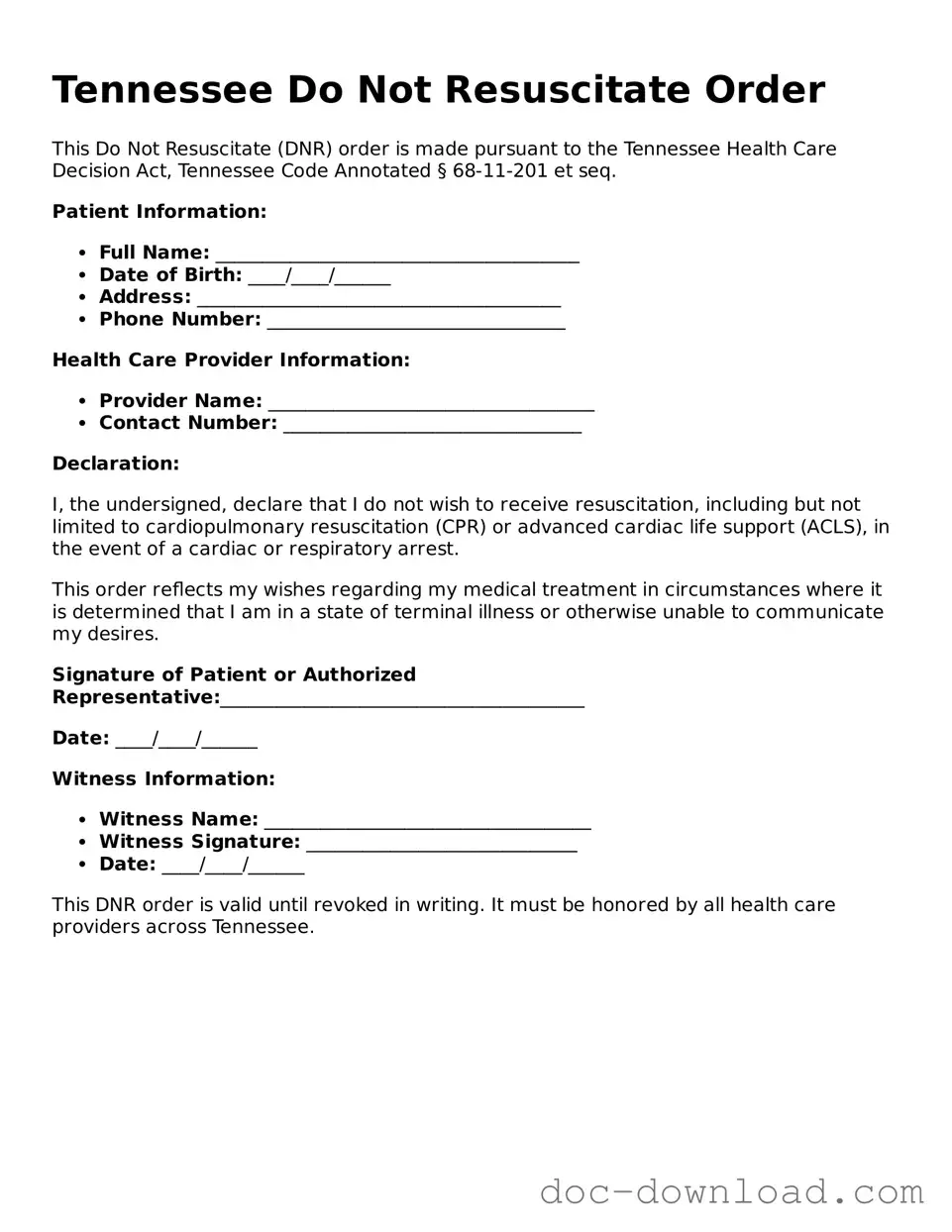The Tennessee Do Not Resuscitate Order (DNR) form is similar to an Advance Directive, which is a broader legal document that outlines a person’s wishes regarding medical treatment in the event they become unable to communicate. An Advance Directive can include specific instructions about resuscitation, as well as other medical interventions. This document empowers individuals to express their healthcare preferences, ensuring that their wishes are respected even when they cannot voice them. Like the DNR, it serves to guide healthcare providers and family members in making decisions that align with the individual's values and desires.
Another document akin to the DNR is a Living Will. A Living Will specifically details the types of medical treatment a person wishes or does not wish to receive if they are terminally ill or in a persistent vegetative state. While a DNR focuses on resuscitation efforts, a Living Will encompasses a wider range of medical scenarios, providing clarity on life-sustaining treatments such as artificial nutrition and hydration. Both documents aim to relieve family members from the burden of making difficult decisions during emotionally charged times, ensuring that the patient’s preferences are honored.
For those involved in motorcycle transactions, understanding the legal documentation is crucial. The Colorado Motorcycle Bill of Sale form serves as an essential tool for smoothly transferring ownership. By using this form, both buyers and sellers can ensure that the details of the sale are thoroughly recorded. For more resources on creating the necessary documentation, visit Colorado PDF Forms which provide valuable templates and guidance.
The Medical Power of Attorney (POA) is also similar to the DNR in that it designates an individual to make healthcare decisions on behalf of another person. This document becomes crucial when a person is incapacitated and unable to express their wishes. While a DNR specifically addresses resuscitation, a Medical POA can cover a broader spectrum of medical decisions, allowing the appointed agent to act according to the patient’s values and preferences. This relationship between the DNR and Medical POA highlights the importance of having clear communication about healthcare wishes.
The Physician Orders for Life-Sustaining Treatment (POLST) form shares similarities with the DNR by providing specific medical orders regarding resuscitation and other life-sustaining treatments. POLST is designed for individuals with serious health conditions and aims to ensure that their treatment preferences are documented and honored by healthcare providers. Unlike a DNR, which is primarily a request not to perform CPR, POLST can include directives for other interventions, making it a more comprehensive tool for managing end-of-life care.
A Healthcare Proxy is another document that resembles the DNR. This legal document allows an individual to appoint someone to make healthcare decisions on their behalf if they become incapacitated. While the DNR provides specific instructions about resuscitation, the Healthcare Proxy focuses on the appointment of a trusted person to make decisions based on the patient's wishes. This relationship emphasizes the importance of having someone who understands the patient’s values and can advocate for their preferences in various medical situations.
Lastly, the Do Not Intubate (DNI) order is closely related to the DNR, as both documents deal with end-of-life care decisions. A DNI specifically instructs healthcare providers not to place a patient on a ventilator or provide artificial ventilation, while a DNR focuses on the absence of resuscitation efforts. Both documents reflect a patient’s wishes regarding life-sustaining interventions and are often used together to create a comprehensive plan for end-of-life care, ensuring that the individual’s preferences are respected in critical situations.
